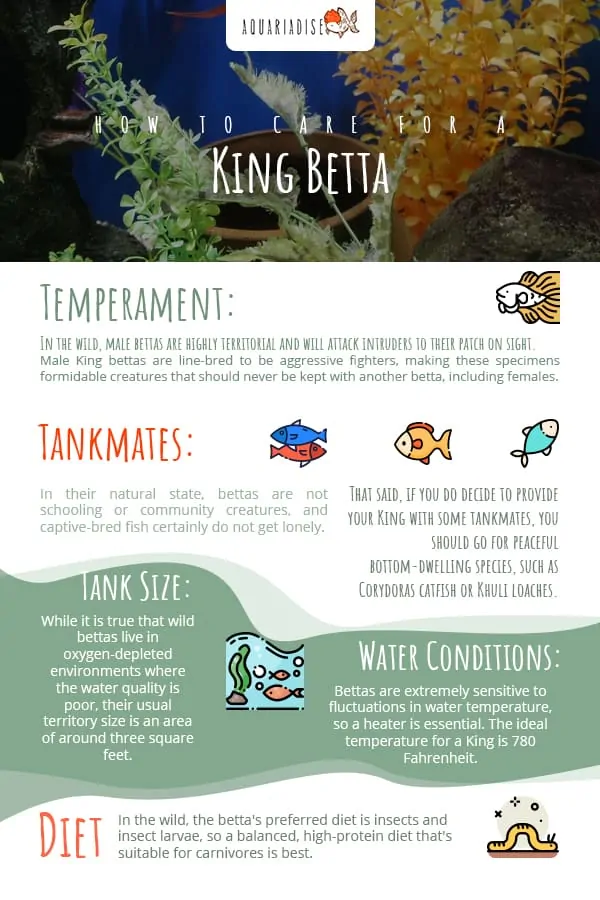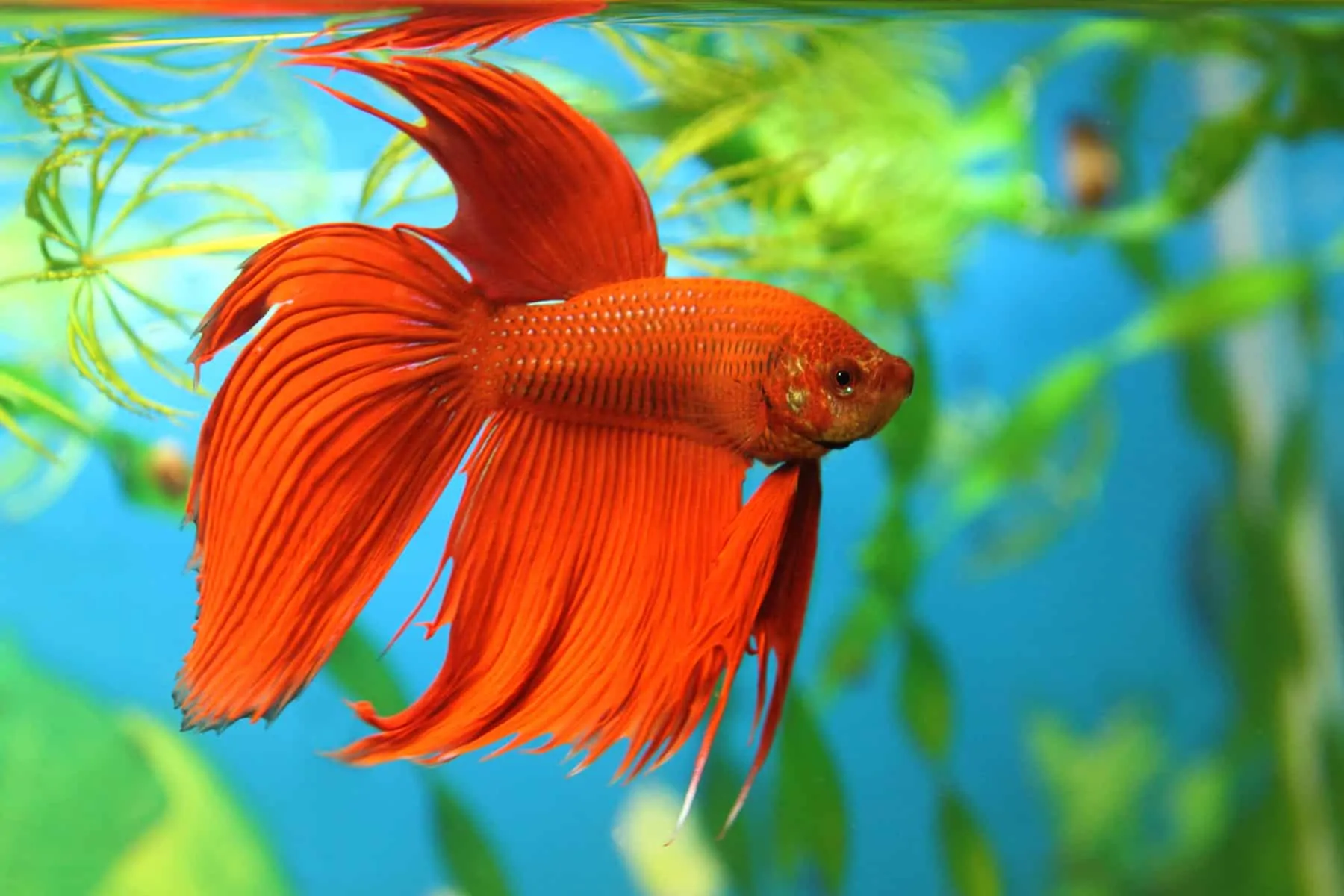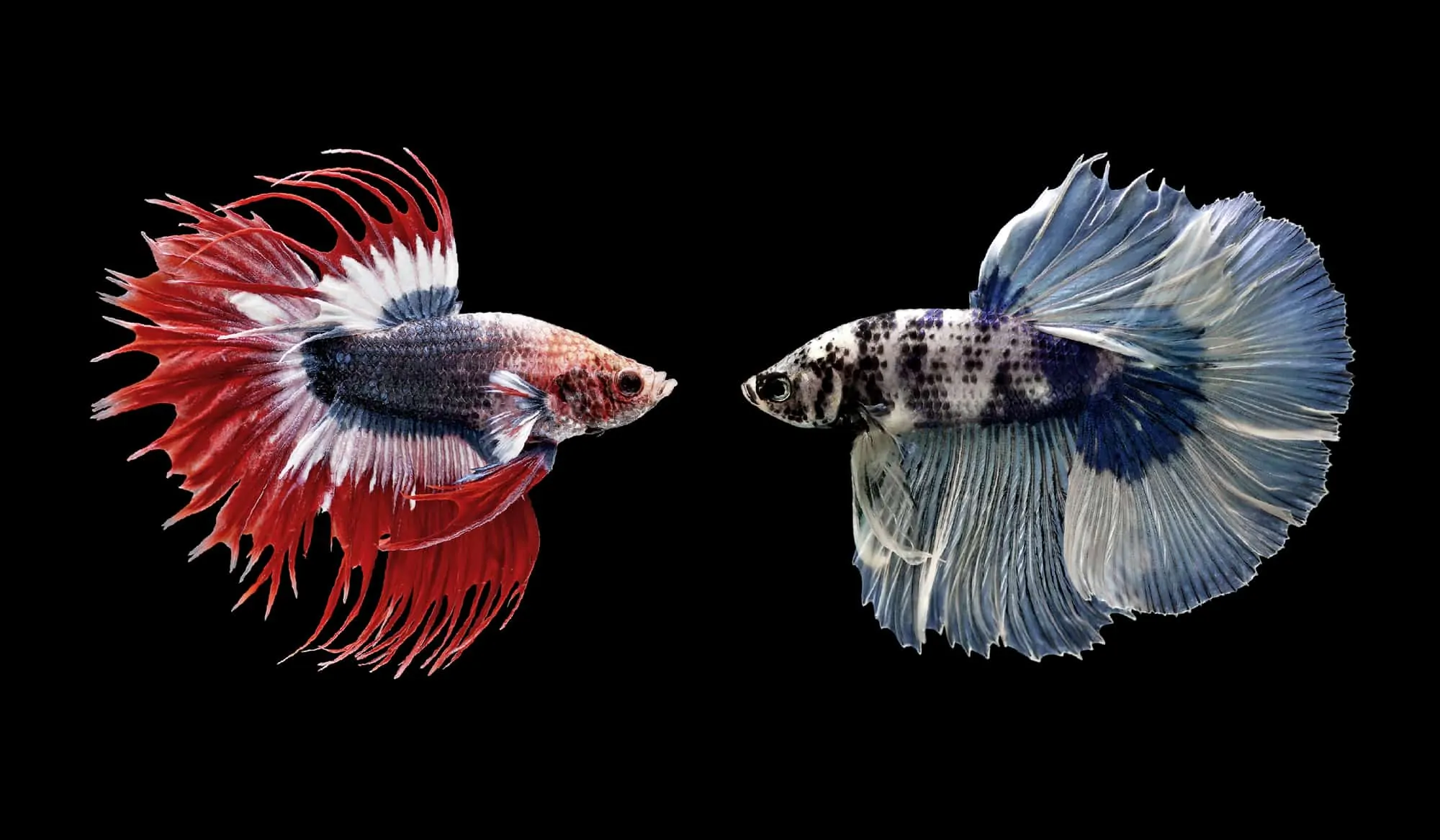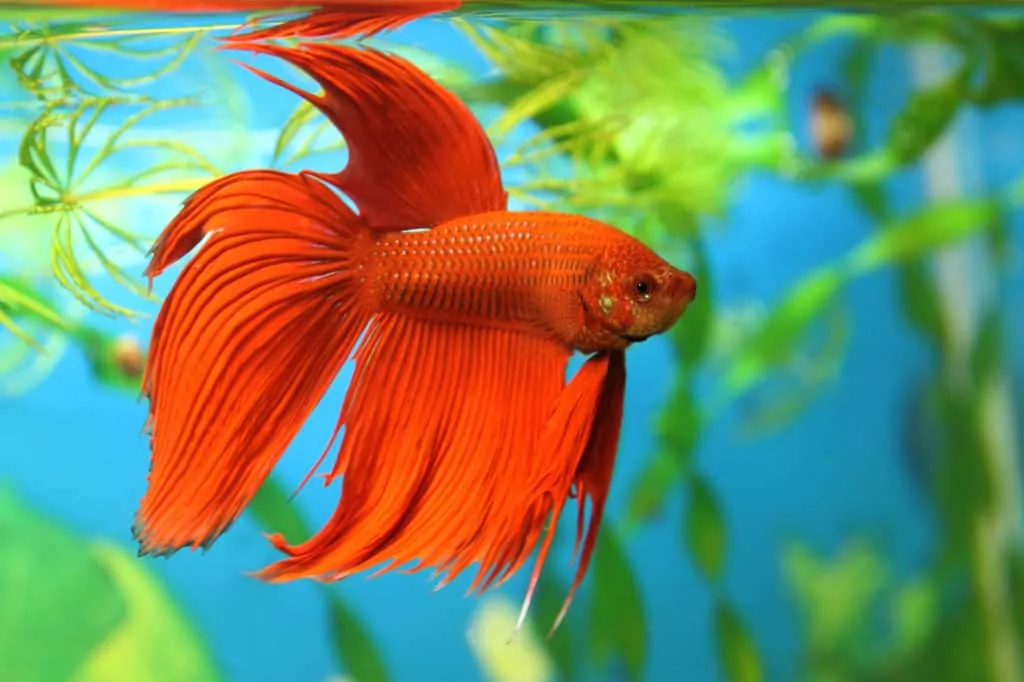Betta fish, also known as Siamese Fighting fish, are popular with hobbyists for their beautiful finnage and dazzling colors. There are over 73 varieties of betta, including the King betta and Giant betta, which are often confused.
In this article, we introduce you to these amazing swimming jewels and tell you how to give your King betta the care he needs to thrive.

What’s a betta fish?
Wild betta fish come from tropical Asia, especially the Mekong and Phraya river basins in Thailand, where the betta lives in shallow bodies of water, including small ponds, drainage ditches, and the paddy fields that are widespread in that location.
All bettas are “anabantoids.” That means that the fish can breathe air, thanks to a specially evolved organ called the labyrinth. That ability means that the betta can thrive in low-oxygen water conditions in which most other fish could not survive. Bettas have an amazing ability to jump. That enables these remarkable, unique fish to leap from one location to another in search of food, to find a mate, or to avoid other males.
Bettas became popular pets around 150 years ago when children began to collect the fish from rice paddies, putting two male fish together to watch them sparring. The contests between these fighting fish became so popular that the King of Siam began regulating the activity and placed a tax on betta fish.
In the 1890s, the fish were imported into Germany and France, and in 1910, the first betta arrived in the United States.
The brightly colored bettas with beautiful flowing fins that you see in pet stores are usually variations of the betta splendens. In contrast, wild bettas, or placats, have dull green coloration and short fins. Over the centuries, the wild placat has been crossbred to produce the rainbow shades and stunning forms that you can see today.
Betta splendens are not big fish, typically growing to around two inches in length or slightly larger if given the right conditions and diet.
What is a King betta?
King bettas are often confused with Giant bettas. However, the King is generally the same size as a regular betta fish, whereas the Giant version can grow to measure four to six inches in length, truly earning its name.
King bettas are thought to be betta imbellis, rather than betta splendens. In their native Thailand, betta imbellis are used for fighting and have been line-bred for super-aggression. Also, their short fins and broad tail make them much faster and more agile swimmers than betta splendens, again designed to make them better fighters.
Imbellis has also been selectively bred for the ornamental trade, being hybridized with several other species, such as betta splendens, betta smaragdina, and betta mahachaiensis to produce several colors and forms that do not occur naturally.
Like all bettas, Kings live for up to three years.

Temperament
In the wild, male bettas are highly territorial and will attack intruders to their patch on sight. As mentioned above, male King bettas are line-bred to be aggressive fighters, making these specimens formidable creatures that should never be kept with another betta, including females.
Tankmates
In their natural state, bettas are not schooling or community creatures, and captive-bred fish certainly do not get lonely. That said, if you do decide to provide your King with some tankmates, you should go for peaceful bottom-dwelling species, such as Corydoras catfish or Khuli loaches. Avoid introducing any species that has trailing finnage or especially bright colors, as that would almost certainly trigger an attack.
Overcrowding will almost certainly cause problems. You should allow one gallon of water per inch of fish. So, if you start with a 5-gallon or 10-gallon aquarium, you’ll need to increase the capacity for each new specimen you introduce.
How to care for a King betta
Bettas have very specific requirements when it comes to their care. To ensure that your King has a long and happy life, you’ll need to provide him with the right environment and conditions.
Tank size
Although many people assume that the betta won’t mind living in a small bowl or vase, that is not accurate.
While it is true that wild bettas live in oxygen-depleted environments where the water quality is poor, their usual territory size is an area of around three square feet. Also, if kept in poor water conditions, bettas can be prone to fin rot, Ich, and bacterial infections.
So, the minimum aquarium size that we recommend for a betta fish is 5 gallons, although if you want to provide your King with a few tankmates, you’ll need a larger tank than that.
These fish are surface feeders. Also, they periodically break the water surface to take gulps of air. For that reason, the ideal tank shape is long rather than tall. Don’t choose a bowl, even a large one, for housing your betta. The rounded size of bowls makes it extremely difficult to install a filtration system, and the surface area is too small to provide space for feeding and air-breathing.
Water conditions
Bettas are extremely sensitive to fluctuations in water temperature, so a heater is essential. The ideal temperature for a King is 780 Fahrenheit.
Water pH should be kept in the range between 5.0 and 7.5
Filtration
The King’s natural habitat is still, stagnant water. So, strong water movement should be avoided, as your fish may become stressed if he continually has to battle against a current. Use an air-powered sponge filter that is set to provide a gentle turnover.
Tank environment
Kings do best in a shady aquarium with plenty of planting that provides surface cover in the form of floating plants, such as Riccia and Salvina. Tall stem plants and tropical lilies are also a good choice and won’t mind the King’s preferred water conditions.
Driftwood may be a good choice of decoration, and you can attach plants to it, such as Taxiphyllum and Microsorum. Bettas like plenty of hiding places, so, be sure to include betta caves in your King’s tank to replicate the conditions in his natural location.
A layer of dried leaf litter on top of a fine gravel substrate can give your King’s tank a natural look while providing a valuable place for the growth of microbe colonies as the leaves decompose. The chemicals and tannins that are released by the leaves are thought to be beneficial in a community tank, and the microbes provide a food source for fry.
Diet
In the wild, the betta’s preferred diet is insects and insect larvae, so a balanced, high-protein diet that’s suitable for carnivores is best.
You should include pellets, frozen foods, and flakes that are specially formulated for bettas. You can also offer live food, including bloodworms, mosquito larvae, and daphnia. However, please do make sure that you source live foods from a reliable supplier so that you don’t accidentally introduce parasites into the aquarium.
Bettas are notoriously greedy and will keep on eating until they are so full that they become bloated. Overfeeding can also cause constipation, which is a common health problem in the species. To avoid these issues, you should feed your fish twice a day, offering only enough food to last him for a minute or so.
A betta’s stomach is roughly the same size as his eye, so you can see how easy it would be to overfeed him.
Breeding King bettas
Like all bettas, King bettas are bubble nesters, and they can be quite easy to breed in an aquarium.
The male creates a nest out of bubbles underneath floating plants or inside shelters. Spawning takes place underneath the nest site, with the male coiled around his mate. The female lays a few eggs at a time, and the male releases his milt to fertilize them. The female catches the eggs between her body and pelvic fins.
Once the eggs have been fertilized and placed in the nest by both parents, the fry hatch within 48 hours, initially feeding on their yolk sacs for a further few days. The fry then begins to swim free, at which time you’ll need to offer them an infusoria-grade food for a few days. After that, you can use Artemia nauplii and micro-worms as fry food.
Note that the tank should have a tightly fitting cover to provide the fry with a layer of warm, humid air. Without that, the development of the fry’s labyrinth organ may be impaired.
Diseases
The betta can be prone to a number of common diseases. Most of these problems are thanks to poor water conditions and stress.
Constipation
Constipation results from overfeeding. Symptoms include:
- poor appetite
- no feces on the tank bottom
- swollen belly
Fasting your betta for a couple of days usually remedies the problem. Also, you could feed your fish a defrosted frozen pea with the skin removed. The fiber content in the pea can help to shift a blockage.
Fin rot
Fin rot is caused by a bacterial infection, causing the fish’s fins to literally rot away to tattered ribbons. Untreated, fin rot eventually finds its way into the fish’s body and may eventually kill him.
To treat fin rot, carry out a water change and dose the tank with an appropriate proprietary medication that you’ll get from good fish stores.
Ick
Ick or Ich is also called white spot disease. Ich is caused by a parasite, presenting as white spots on the fish’s body, gills, and finnage. Affected specimens will flick their bodies against the substrate, rub against hard tank surfaces, and clamp their fins in an effort to dislodge the parasites.
Again, a proprietary white spot treatment added to the water will usually kill off the parasites within a few days.
Velvet
Velvet is also caused by a parasite. Affected fish have a gray coating on the body. Like Ich, Velvet can be treated with medication that you’ll get from your local fish store.
Fungal infections
Stressed and injured fish often fall victim to fungal infections, which leave the fish with fluffy white patches that resemble cotton wool.
Affected specimens can be treated with fungicide added to the aquarium and spot treatment with gentian violet or methylene blue.
Swim bladder disease
The fish’s swim bladder is a structure that enables the fish to swim normally. If your King has swim bladder disease, he may tip onto one side, float up to the top of the tank, or even become trapped upside down.
Swim bladder disease is usually caused by a bacterial infection that is triggered by poor water quality, injuries, and stress. To treat swim bladder disease, treat the water with antibiotic medication, and carry out partial water changes each day until the fish recovers. You may also find that moving the affected fish to a container containing just a few inches of water can help to relieve stress and promote a full recovery.

Availability
King bettas are not as easily available as standard small varieties. However, suppliers such as
When purchasing a King betta, be sure to check that the fish you’ve chosen isn’t a Giant betta, which is a different, much larger variety altogether.
FAQ
King betta fish are not as commonly seen as regular betta splendens, and understandably, potential buyers have lots of questions about these stunning fish. Here, we tell you the answers to the most frequently asked questions about Kings so that you have all the information you’ll need.
Q: How big do King bettas get?
A: King bettas grow to the same size as regular betta splendens, reaching up to two inches in length. Giant bettas can be six or even seven inches long.
Q: Are King Bettas more aggressive?
A: Although aggression is an individual thing, Kings are line-bred to be aggressive fighters. So, it is likely that a King will be more feisty than a regular betta.
Q: How long do King betta fish live?
A: Kings have the same average lifestyle as other varieties, usually two to three years, with some specimens making it to four years of age.
Q: What is a Koi Betta?
A: Koi bettas are a variant of the marble betta. These specimens have the same marbled colors and patterns of the popular Koi carp pond fish.
In summary
The King betta is a variant of the wild placat, which has been line-bred to produce an aggressive fighting fish. Kings lack the luxuriant, flowing finnage of splendens, but they do come in a wide range of stunning colors.
Please don’t rush to
However, if you think that you would like a new 10- gallon tank, that would be the best option, as you could provide your King with his very own domain.



I have a male paradise gourami fish named (BLUETIGER). He will be bred with a secret blue female fighter plakat bettafish to make a new generation of ROYAL kings and queens. They won’t tolerate any stuff from the republican/gop south American leaffish.